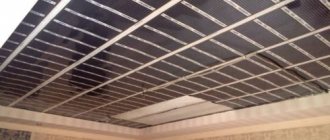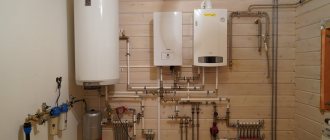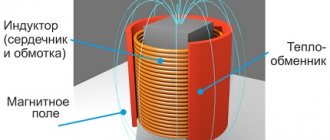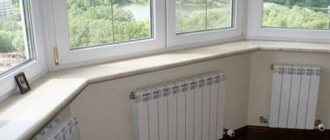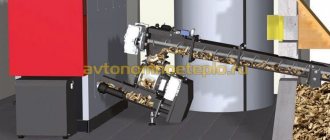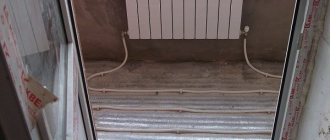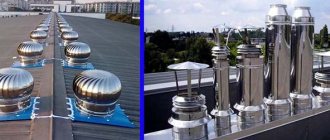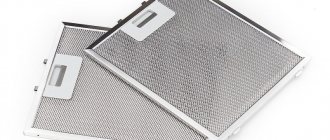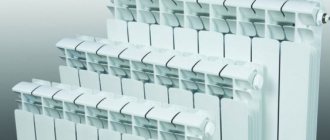In search of a more efficient heating system, people have tried many options, of which underfloor heating has become the most successful. Warm floors are usually installed during housing construction or renovation, since its installation requires a complete change in the heating system and floor structure. The advantage of this heating system is the large heat-transferring surface area. Let us examine in detail the delights of heating a house with warm floors.
Electric heated floor
Installation of electric heated floors can begin at any time during repair work. According to the type of heating, electric heated floors are divided into cable, thermomats (heating mats) and film. Heating occurs using a cable or any other heating device by supplying electricity.
The underfloor heating cable can be considered as the main heating system. But due to the high cost of electricity, it is most often used in small areas (bathtub, corridor), where it serves as the main heating.
How to install?
Proceed with installation only if you are fully confident that you have the required knowledge, skills and tools. In this case, the best option would be to turn to professionals. Often, stores that sell floor-mounted batteries offer their installation services. Thus, they bear full responsibility for the operation of the system and assume all warranty obligations.
But if you still decide to do it yourself, study the procedure for performing the work:
- coolant or electrical cable supply;
- installation of a niche;
- floor filling;
- radiator installation;
- adjustment of its height using bolts;
- fixation of the entire structure in a niche, insulation, sealing of gaps between the walls and the metal box;
- arrangement of the final finished floor;
- connection to the electrical network or centralized heating;
- sealing cracks using silicone sealant;
- installation of a protective grill.
Water heated floor
A type of underfloor heating that can be equipped with an autonomous water boiler or central heating (using a special heat exchanger). Does not work without a pump and requires one.
In addition to pipes, a water heated floor includes: thermal insulation (expanded polystyrene), damper tape, fasteners, special accessories for making expansion joints, as well as the manifolds with fittings necessary to connect the underfloor heating system to the heating system.
Thanks to its water component, it can operate from any boiler and does not depend strictly on electricity. Not counting the operation of the pumps themselves. An excellent solid heating system for your home.
Where can underfloor radiators be installed?
Unlike wall-mounted ones, in-floor radiators are universal. Installation can be carried out in any room, regardless of its purpose - office, residential, commercial, etc. Can be installed in houses with French windows.
Built-in batteries in the bathroom Source batareya.com.ua/
They can be used to organize heating of greenhouses, shops, art galleries, halls, hallways, corridors, even in rooms with a special artificially created microclimate - in museums, houses where panoramic windows are installed.
Built-in batteries in a children's room Source konvektors.in.ua
Myths about heated floors
Is underfloor heating harmful to health? The peculiarity of heating a house with heated floors is that it is picky about installation technology. Failure to comply with the technology significantly affects the performance of the system. This is where myths regarding the dangers of heated floors are born.
If you install the floors correctly, then you don’t have to worry about any consequences.
Regarding electromagnetic radiation when installing an electric heated floor, many myths have also been born about it. Yes, indeed, like any electrical device, radiation occurs, but the intensity is so low that even insects will not notice your heated floor.
Principle of operation
Heating a room using them occurs as follows. Cold air enters through a special grille to the radiator, heats it up and exits back into the room through the same grille. By circulating in this way, it ensures that the temperature in the room rises to the desired level.
Battery design in the floor Source yms.com.ua
To make a radiator grille in the floor, wood or metal painted in different colors can be used. Those made of metal are more wear-resistant, but at the same time, with strong heating, they can cause discomfort if you step on a bare foot, while the user is guaranteed not to get burned. Wooden ones can be damaged by strong force or pressure. Grilles can have different sizes and appearance, which allows them to be harmoniously combined with a particular room interior.
External battery grille in the floor Source carrera.ua
Installation is carried out close to the windows. In this case, a relief valve is always installed, connected to the radiator. It allows you to remove air from the system, which significantly increases the efficiency of radiators. Special regulators make it possible to set the required temperature in the room.
Heating a house with a warm water floor
When discussing the features of heating a house with a water floor, many developers are interested in factors that we will explain below.
System life
Manufacturers like to mention that underfloor heating can last at least 50 years. Underfloor heating pipes are designed for this period. Regarding external parts: manifold, taps, etc., most likely they will fail sooner. But changing them won't be a big problem.
Our experience suggests that buildings from 1996 to this day are doing quite well and the underfloor heating system works without problems.
System efficiency
Manufacturers often like to mention that heating a house with underfloor heating as the main source of heat is more economical than many other heating systems. As practice shows, in most cases you do not get significant savings. But condensing boilers, heat pumps and solar collectors (for additional heating) can be connected to heated floors. In these cases, flooring can be significantly more economical.
Comfort
Many developers are confused by the fact that the floor will be uncomfortable to walk on. It will also be uncomfortable to sleep at night. The surface temperature of the heated floor is only 28 degrees. You will practically not feel it. For the bedroom, you need to provide a room thermostat so that you can set a comfortable temperature.
Types of pipes for heating in the floor
| Pipe type | Advantages | Flaws |
| Polypropylene pipes | Low cost of pipes and connecting elements. Relatively simple installation procedure. Service life – 20-30 years. | Pipes don't bend well. Products are not sold in coils, only in short lengths. It will not be possible to mount a circuit without connections. They have the highest level of thermal expansion. Inferior to other options in terms of thermal conductivity. |
| XLPE pipes | Affordable. Sold in coils. Depending on the brand of polymer, they operate at temperatures from +55 to +120°C. Resistant to freezing and defrosting of the media. Long service life. | Not good enough flexibility. High coefficient of thermal expansion. They don't hold their shape well. A large amount of fasteners will be required for reliable fixation. Sensitivity to external damage. Care should be taken during installation. |
| Metal-plastic | Pipes are sold in coils. Permissible media temperature +95°C. Low level of thermal expansion. Good ductility. At gentle operating temperatures, the carrier life reaches 50 years. | Metal-plastic pipes are more expensive than their polymer counterparts. Frequent temperature changes can cause pipe delamination. Constant operation at high temperatures reduces the service life by almost half. |
| Copper pipes | Copper has the lowest coefficient of thermal expansion. Capable of being used effectively for 50 years or more. Easily withstand prolonged exposure to working environments with temperatures up to +115°C. | High cost and complexity of installation, which is unlikely to be done on your own. It is better to entrust this work to a professional. Poor compatibility with other materials, especially metals. |
We recommend that you read: The best metal-plastic pipes for installing heated floors and how to install them correctly with your own hands
Note! The use of iron and steel pipe products for heated floors is strictly not recommended. The main reason is corrosion, which will certainly appear with constant interaction of metal with water. The only exception is corrugated stainless steel.
Warm floor or radiators. What's better?
Radiator heating has a number of advantages and disadvantages. The advantages of radiators are an affordable price for all segments of the population, a large selection, and widespread availability.
The disadvantages of radiator heating include the strictly horizontal installation of radiators, which contributes to irrational heat distribution. Warm floors warm a house much more evenly than radiators.
In terms of consumption, both systems will be comparable, but water heated floors are more expensive to install.
Having analyzed the advantages and disadvantages of both heating systems, we can conclude that the optimal option for heating a room is to combine radiator heating with a heated floor system. In this case, the advantages of both systems are combined, and their disadvantages are eliminated. The main advantage of using both heating systems is that they work autonomously from each other, and if one of the systems breaks down, you can use the second.
Underfloor heating: advantages and disadvantages
Before hiding heating pipes in a concrete screed, it is necessary to study in detail all the pros and cons that this heating system demonstrates. They should not be ignored, because this will guarantee that the finances will be invested wisely.
Let's look at the advantages of an underfloor heating system.
- Long period of use.
- Uniform heating level.
- The system in concrete poured into the floor is distinguished by cheaper maintenance when compared with classic options.
- Easy care.
- No moisture.
- Economical use of space.
- Complete safety (installation of the system in a concrete screed allows you to avoid child injuries and burns from hot pipes).
- The required level of humidity is constantly maintained in the air.
There are not many disadvantages of a network under a screed, but you need to familiarize yourself with them.
- First of all, when laying the heating line under the screed, the height of the room is reduced.
- Repairing pipes is not as easy as in classic cases, because finding a leak in a hidden pipeline is not easy.
- It will not be possible to carry out installation in specific places. These include a flight of stairs, etc.
IMPORTANT! These buildings in mansions can be carried out without restrictions, but an apartment will require a different approach. In apartment buildings, you need to make sure that the central network can cope with the large hydraulic load.
The disadvantages must be carefully studied, and you need to be prepared for the fact that sooner or later the heating in the screed may leak. Do not forget that pipe leaks in such structures are not easy to detect.
And after determining the location of the leak, repairs will not be easy. Therefore, it is important to approach the work with full responsibility.
Underfloor heating scheme.
There are three main types of water floor installation.
Snail or spiral
The most popular, economical and energy efficient method of laying water heated floor pipes. The snail-shaped pipe laying scheme first describes the perimeter of the room, starting from the edge, and tends to the center of the room, constantly reducing the radius, and then in the opposite direction.
The advantage of this method is the step length - the snail can be mounted in steps from 10 mm to any convenient size. There is also an even distribution of heat. This method of laying a water heated floor pipe is the least labor-intensive due to the slight bending of the pipe. If you really want to, even one builder can handle the installation and you won’t have to spend money on additional labor. The method of laying pipes in the form of a snail allows you to install a heating system in rooms of any size and various shapes.
Requirements for pipes
Water is often used as a coolant. Much less common are solutions that use ethylene glycol or antifreeze for these purposes. The efficiency of the entire heating system will largely depend on the correct choice of pipes. When choosing pipe material, preference is given to one of these options:
- Polypropylene pipes.
- Pipes made of cross-linked polyethylene. There are low, medium and high densities.
- Metal-plastic products.
- Copper pipes.
We recommend that you read: Is it possible to pour polypropylene pipes into a screed?
You should focus on the following important indicators:
- Strength. It has a direct impact on the resistance of the pipeline to changes in pressure and temperature.
- Resistance to corrosion.
- Thermal expansion coefficient. Should be as small as possible. Insufficient values of the indicator are fraught with violation of the integrity of the pipeline and concrete screed. The indicator is measured in absolute elongation for every 10 meters of pipe when heated to +50°C. Polypropylene can elongate by 80 mm, polyethylene by 70. A hybrid metal-plastic product has an indicator of 10-15 mm, copper has the lowest coefficient - less than 10 mm.
- Thermal conductivity. Characterizes what proportion of thermal energy will be given to warm the room.
- Environmentally friendly. Safety of the material for the health of people in the room.
- Pipe bending radius. Affects the possibility of constructing circuits of various configurations. Polypropylene products bend the worst (the bending radius is equal to 8 pipe diameters). Polyethylene can be bent without loss of quality with a bending radius of no more than 5 diameters. Copper and metal-plastic are very flexible, but it is better to entrust the bending procedure to a pipe bender, or use springs. This will allow the bend to maintain a round cross-sectional shape.
It is important! The number of pipe connections in the circuits should be as small as possible. Ideally, each circuit should be a single piece of pipe.
The pipeline is laid according to one of two main schemes - a snake or a snail (spiral):
- In the first case, the loops go from wall to wall with a 180° rotation.
- In the second, the pipe runs in a circle from the wall to the center of the room.
For residential premises, a volute is more often used; this scheme ensures more uniform heating of the floor surface. In addition, spiral laying involves only one sharp bend, in the central part of the pattern. Here it becomes possible to use pipes with a large bending radius.
Method of laying pipes in the form of a snake
This scheme for laying water heated floor pipes has large heat losses due to the fact that hot water is supplied only from one side and loses all energy when reaching the end of the scheme. Thus, we get a warm floor at one end of the room and a gradual decrease in temperature as we move away from the coolant mixing unit. Another disadvantage of laying with a snake is the difficulty of installation. The pipe bends 180 degrees. Very often you have to take a step of 200 mm versus 10 for the snail.
In order to reduce the temperature difference in the snake system, you can make a double snake. However, this will not completely solve the problem of labor-intensive installation of water-heated floor pipes.
The best option for using a snake is to combine one method with the second. Or first you need to cut off the outer walls, then lay the snake in the middle of the room. This results in an optimal temperature distribution. A combined scheme involves mixing methods for laying heated floors or duplicating them. For example, two turns of a snail or several snakes in a row. If the layout of the room allows, then you can mix methods for laying out a warm water floor. For example, at the entrance, where heating is not particularly needed, put a snake, and in the center of the room, in order to concentrate useful energy, spread a snail. Before starting work, it is best to draw a diagram of the water heated floor on the plan. Thanks to this, future work on installing a water heated floor will become much easier.
What types of materials can be used and which cannot
Before making a screed, you need to find out which heating pipe materials are most suitable for installation in the floor. There are many options - you can choose products made of copper, you can choose such an inexpensive and practical material as plastic, which, if installed correctly, will work one hundred percent.
It is also worth paying attention to metal-plastic products. Which one is better to choose? In order to answer the question posed, let’s look at pipes made from the listed materials in more detail.
Pipe products for laying in the floor must have the following properties.
- High strength index.
- Resistant to corrosive formations.
- Impermeability to oxygen, which causes corrosion of steel parts of the heating network.
- Good heat dissipation.
- Low expansion coefficient.
- Environmentally friendly.
The listed requirements for laying in the floor under a screed are fully met by a range of the following materials - polyethylene, polypropylene and metal-plastic.
Polyethylene pipes
and other types of pipes that are used in screeds have pros and cons, therefore, before hiding them and making screeds, you need to study each material thoroughly.
Polypropylene pipes
for laying in screeds they are favorably low in cost. But these products have not found widespread use. The reason is that polypropylene pipes hidden in a screed have a number of significant disadvantages.
Thus, the polypropylene (PP) range is distinguished by an eight-diameter bend radius. When laying a polypropylene underfloor heating system, this affects the distance between adjacent main branches.
If the diameter of the polypropylene line is 15 mm, then the branches will move 120 cm apart from each other, which will have a bad effect on warming up the room. It is also possible to install a polypropylene water-heated floor only at a temperature of at least fifteen degrees. Products made from polypropylene are inexpensive and have a large number of positive characteristics.
Polyethylene pipe materials
Only cross-linked ones are suitable for this task. Cross-linked polypropylene is durable, reliable and resistant to high temperatures. But, in a cement floor, these pipes do not hold their shape well. Therefore, to fix such pipes it is necessary to use a large number of fasteners.
Experts speak well of metal-plastic products. The metal-plastic pipe used in the screed lasts quite a long time.
Metal-plastic products appeared on the market not so long ago, but quickly took a leading position. The special three-layer design of these pipe materials allows them to last up to 30 years.
The disadvantages of metal-plastic pipelines include the relative complexity of installation work at home. It’s not difficult if you have some experience in this kind of work.
Therefore, it is important to know the sense of proportion when clamping. At home, laser or ultrasonic welding is not used for this range.
If you don't clamp the joint well, you should expect leaks. And, if you “pinch”, the fitting will fail and will have to be replaced.
And here is a rolled
included in the list of impeccable leaders. It is much superior to its polyethylene counterparts. Cross-linked polypropylene and metal-plastic are also inferior to copper. In this case, there is only a huge list of positive characteristics.
Watch the video
But copper products have one drawback. is too high
, which becomes the reason that not everyone can afford to use a structure made of this material for laying under a screed.
Speaking about the “warm floor” system, you need to remember such a material as metal. Metal pipe products
In the screed, experts call it an unreasonably risky undertaking.
The water in the heating network is often saturated with chemicals
, and the metal may simply
not
withstand this aggressive influence.
Ultimately, corrosion appears in the metal structure, which means further leakage. Hard water also has a detrimental effect on metal.
Therefore, plastic and copper products are a more practical solution for laying in the floor. Therefore, metal pipe-rolling materials are not recommended for this work.
Preparing the premises
Before sealing the heating pipes in the floor screed, it is necessary to remove all supply points for other communications and install windows and doors. It is recommended to remove pieces of furniture from the room and dismantle the old heating system, if this work is not carried out in new buildings.
Irregularities on the surface are allowed within a radius of one centimeter. If their dimensions exceed these indicators, then the base for heating should be leveled.
The final stage of preparatory work is cleaning. It must be done before sealing the structure with a concrete screed. Industrial vacuum cleaners cope with this task perfectly.
Laying “warm floor” in a screed
This option is used in apartments and private houses. It is even used for wood flooring, or under a coating such as laminate.
Filling is performed on a rough or wooden floor. They act in these situations according to the same principle.
- Spread waterproofing.
- Install insulation.
- Lay reinforced mesh.
- The pipeline is being laid out and secured.
- Glue damper tape.
- The entire structure on the floor is filled with mortar.
We carry out waterproofing
It protects against moisture and prevents wet mortar from coming into contact with the floor. Afterwards it is necessary to insulate the working surface. The best option for this task is polystyrene foam. A foam-derived material, Penoflex, also received high marks from experts.
A steel mesh is applied to the insulating material. It is needed to evenly distribute the load over the frozen fill. Without such reinforcement, the screed may crack.
Piping in such networks is carried out in two ways.
- A snail.
- Snake.
The first scheme is laying in a circle from the walls to the center of the room. In such actions, sharp turns of the circulation direction are not used.
The snake is directed from any wall, and then goes to another, located on the opposite side. With this design, on all pieces the direction of movement of the liquid changes by 180 degrees. In everyday life, the first installation option is most often used.
The contour should be strengthened on the surface part. When doing these actions, it should be taken into account that it increases the dimensions in length. Consequently, the fasteners cannot be rigid, and the pipeline must have the ability to slide. For this task, plastic clips attached to the floor are effectively used. You can also install simple clamps.
It is very important to remember to use damper tape. It is a strip of foamed polymer material. It needs to be glued around the perimeter of the room on the wall. And the bottom edge of the tape should be drawn along the floor. This measure will help level out the increase in filling and will not allow the solution to stick to the walls.
Many people are interested in how many centimeters the screed must cover the pipe structure. The masters say that it cannot be less than three centimeters. Its optimal size is 7 cm.
Watch the video
When laying heating pipes, it is very important to maintain the same pitch between turns or zigzags. So, for example, for a room of 20 square meters. m, this distance is equal to twenty centimeters. In a room with a large area, it is recommended to install several spirals or coils for heating.
Heating pipes in the floor can be hidden under wet or dry filling. The first method is more common. Because when “dry” filling voids, the density level is lower, and because of this, heat transfer is slowed down.
It is not difficult to build such a heating structure with your own hands. The main thing is to have patience and some knowledge. If you add a little more diligence to this, then the excellent results of floor heating can delight you for many decades.
(2
ratings, average:
5.00
out of 5)
Discussion is closed.
Often, when people hear the word “heating,” they think of the heavy, rough, cast-iron radiators that were present in everyone’s home during the Union era. The radiators took a long time to warm up, did not retain heat in the apartment, and performed their function somehow. Nowadays everything is different - there is an opportunity to choose among worthy alternatives. The most advanced of them is the “warm floor” system. Therefore, we learn how to install heating pipes in a floor screed.
Warmth starts from the feet
Features of installation of in-floor radiators
As for heating systems, the creation of which uses radiators built into the floor, such a task is not particularly difficult and does not require special professional skills. Anyone who has basic knowledge of heating engineering and can perform basic construction work can perform high-quality installation without any problems.
When you decide to install radiators built into the floor yourself, you should take into account a number of points that significantly affect the duration of operation, heating efficiency and money savings.
These include:
- pressure in the heating system. In-floor water batteries are among the most popular solutions for heating private households, since the pressure in an autonomous radiator heating structure is relatively low and almost never exceeds 2.5 atmospheres. It should be noted that experts do not recommend using such floor radiators for centralized systems, since the coolant supply standards in them require a pressure of 6-12 atmospheres and for this reason the floor heating system will quickly become unusable. In cases where it is impossible to do without built-in radiators, copper batteries should be installed that can withstand a working pressure of 10-15 atmospheres;
- room height. The thermal power of radiators built into the floor, and accordingly the cost of heating equipment, directly depends on how high the ceilings are. The larger the cubic capacity of the room, the greater the volume of air that requires heating. Heat transfer efficiency is calculated in the ratio of 1 kW per 10 “squares” of area;
- When installing underfloor water heating, it is necessary to ensure the supply of all power supply systems. These works should be included in the construction estimate at the design stage of the house or when planning repairs, otherwise it is impossible to ensure the normal functioning of the heating system. The only solution will be to install an electric convector;
- selection of equipment. Currently, choosing heating equipment built into the floor depending on your wishes is not a problem. The assortment is large and the system is chosen based on the materials of the radiators, their shape and size. As a rule, water radiators have a standard design solution, and the instructions for their operation are not much different. Some models are equipped with powerful fans, thanks to which the heat transfer of heated air from the radiators into the room is significantly increased, since the circulation of air masses improves, which means the heating system works more efficiently;
- when radiators are installed in the floor, the dimensions of the channels are determined depending on the parameters of the housing. Experts recommend making them 110 millimeters deep and 190 to 400 millimeters wide. Depending on which installation method is used, the distance from the floor to the radiator can be from 10 to 80 centimeters.
After installing radiators in the floor, consumers can achieve not only inexpensive and high-quality heating, but also create an unusual modern interior of the room, in which there will be no unnecessary elements.
